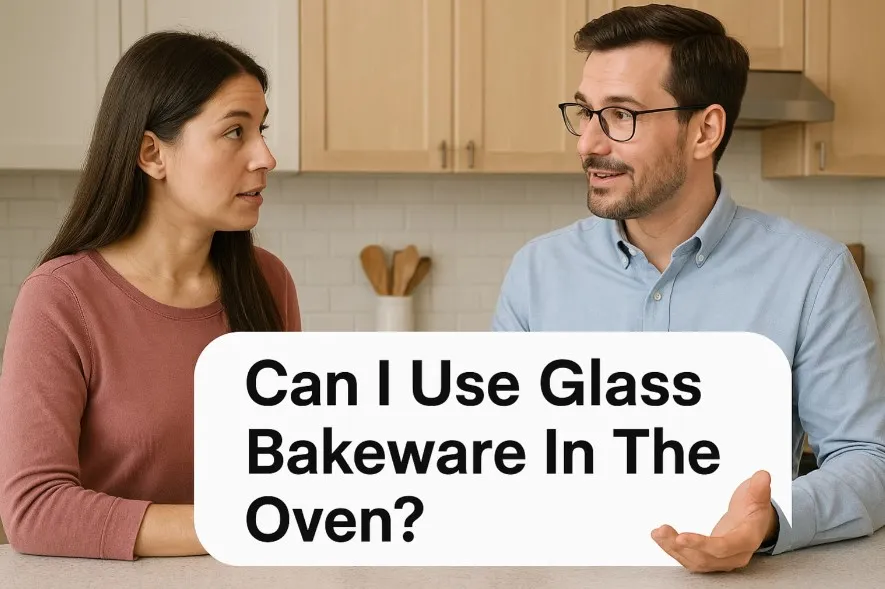Can I use glass bakeware in the oven? Absolutely, but there’s a catch. It must be labeled as oven-safe. Trust me, I’ve learned this the hard way! If the dish isn’t designed for high heat, it could crack or shatter. You don’t want that mess—or the risk of injury. Always check for the oven-safe label before using glass bakeware. It’s a small step that makes a big difference in keeping your cooking stress-free and safe.
Summary Points
- Look for an ‘oven-safe’ label on glass bakeware first. This keeps it safe and stops it from breaking.
- Tempered glass is tougher and works better for baking. Pick tempered glass for dependable cooking.
- Do not use decorative glass in the oven. It might break or crack from high heat.
- Stop glass bakeware from breaking by avoiding quick temperature changes. Let it cool down before washing.
- Don’t put glass bakeware under a broiler. Use metal or ceramic dishes for very high heat.
Can I Use Glass Bakeware In The Oven Safely?
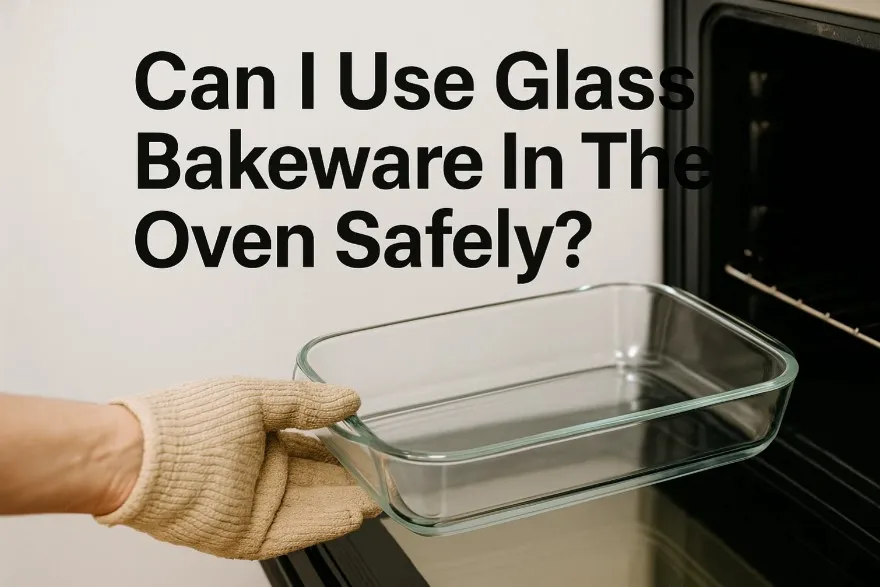
Understanding Oven-Safe Labels
When I started using glass bakeware, I didn’t know labels mattered. These labels aren’t just for looks—they help you cook safely. If the dish doesn’t say “oven-safe,” don’t use it. Regular glass can’t handle high heat. It might break or shatter, and cleaning broken glass is awful.
Oven-safe glass, like Pyrex, is made to handle heat and sudden changes. You’ll find labels on the dish, usually on the bottom. Look for “oven-safe” or a trusted brand’s logo.
Tip: Unsure if your dish is safe? Don’t risk it. Use bakeware with clear labels to stay safe.
Differences Between Tempered and Non-Tempered Glass
Not all glass is the same, and I learned this the hard way. Tempered glass is stronger and handles heat changes better than regular glass. It’s great for ovens.
Non-tempered glass is weaker and cracks easily. Moving it from a hot oven to a cold surface can break it. Tempered glass is tested to resist heat shock and has improved over time. For example, soda-lime-silicate tempered glass is 40% better at handling heat than older borosilicate glass.
Note: When buying bakeware, pick tempered glass for safety. It’s worth it.
Why Decorative Glass Should Not Be Used
Decorative glass dishes look nice but aren’t made for baking. They’re often non-tempered or have painted designs that can crack or peel in the oven.
Decorative glass is great for serving but risky for cooking. Using it in the oven can cause breakage, ruin your dish, and even cause injuries. Always use bakeware labeled “oven-safe.”
Warning: Don’t use decorative glass in the oven, even at low heat. It’s unsafe.
Tips to Prevent Glass Bakeware From Shattering
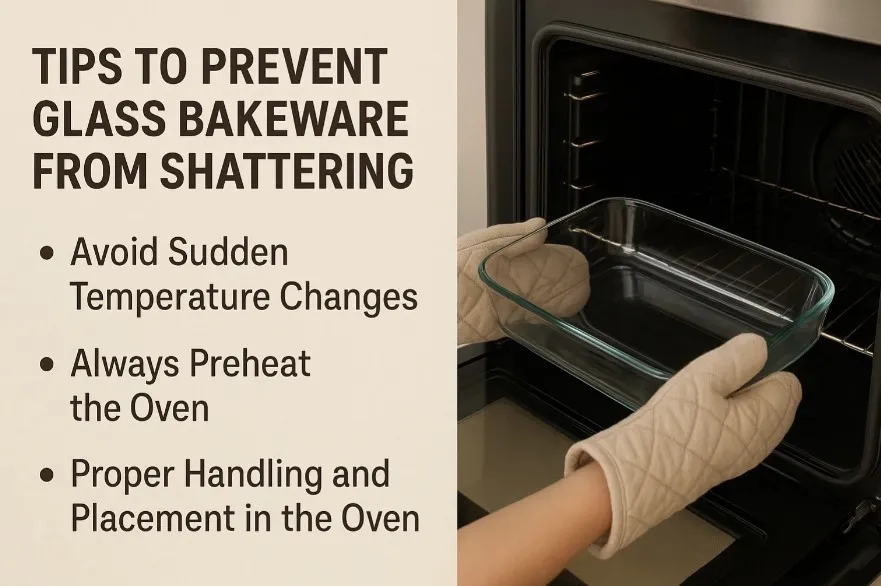
Avoid Sudden Temperature Changes
One of the easiest ways to keep your glass bakeware safe is to avoid sudden temperature changes. I’ve learned this the hard way—taking a hot dish straight from the oven and placing it on a cold countertop can cause it to crack. Glass doesn’t handle thermal shock well, so it’s important to let it adjust gradually.
Here’s what I do to prevent this:
- Always let the dish cool down before washing it.
- Use a trivet, potholder, or dry towel when placing hot bakeware on a surface.
- Never pour cold liquid into a hot dish.
These small steps make a big difference in keeping your bakeware intact.
Tip: If you’re reheating leftovers, let the dish sit at room temperature for a few minutes before putting it in the oven.
Always Preheat the Oven
Preheating the oven is a must when using glass bakeware. I used to skip this step, thinking it wasn’t a big deal. But I quickly realized how important it is. Preheating ensures the oven reaches a consistent temperature before you place your dish inside. This prevents sudden heat exposure, which can lead to cracks or even shattering.
Here’s why preheating works:
- It allows the glass to heat up gradually along with the oven.
- It reduces the risk of thermal shock by avoiding uneven temperature changes.
- It helps the food cook evenly, which is always a bonus!
Now, I make it a habit to preheat every time. It’s a simple step that protects my bakeware and improves my cooking results.
Reminder: Never put glass bakeware into a hot oven straight from the fridge. Let it sit at room temperature first.
Proper Handling and Placement in the Oven
Handling glass bakeware carefully is just as important as how you use it in the oven. I’ve picked up a few best practices over the years to keep my dishes safe and long-lasting.
Here’s what I recommend:
- Let the dish reach room temperature before using it.
- Always preheat the oven before placing the dish inside.
- Add a bit of liquid to the dish before cooking to prevent uneven heating.
- Avoid adding liquid to a hot dish—it can cause cracks.
- Never use glass bakeware over direct heat, like on a stovetop or under a broiler.
- When removing a hot dish from the oven, place it on a dry cloth or trivet instead of a cold surface.
These steps might seem small, but they go a long way in preventing accidents. I’ve followed them religiously, and my bakeware has lasted for years without any issues.
Pro Tip: If you’re using Pyrex or similar brands, always check the manufacturer’s guidelines for safe use.
Why Glass Bakeware Should Not Be Used Under a Broiler
I’ll admit, I’ve made this mistake before—thinking my trusty glass bakeware could handle anything, including the broiler. Spoiler alert: it didn’t end well. Glass bakeware and broilers just don’t mix, and here’s why.
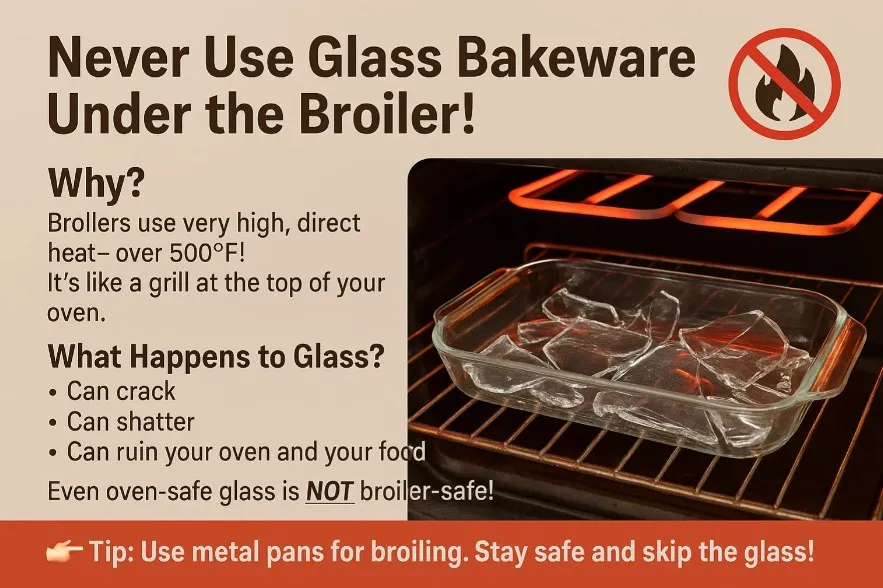
The broiler works by exposing food to intense, direct heat from above. It’s like a grill inside your oven, reaching temperatures of 500°F or more. Glass bakeware, even if it’s labeled oven-safe, isn’t designed to handle that kind of heat. The extreme temperature can cause the glass to weaken, crack, or even shatter. Trust me, cleaning up shards of glass from a hot oven is not how you want to spend your evening.
Warning: Never place glass bakeware under a broiler, no matter how tempting it might seem. It’s not worth the risk.
What Happens When Glass Is Exposed to a Broiler?
When glass bakeware is exposed to the broiler, it faces two major problems:
- Uneven Heating: Glass heats up slower than metal. Under a broiler, the top surface of the dish gets blasted with heat while the rest of the glass remains cooler. This uneven heating creates stress points, which can lead to cracks or shattering.
- Thermal Shock: If you’ve ever taken a hot dish out of the oven and placed it on a cold surface, you know how sensitive glass is to sudden temperature changes. The broiler’s intense heat creates a similar effect, but from the inside out. The rapid temperature spike can cause the glass to fail catastrophically.
Safer Alternatives for Broiling
If you need to broil something, skip the glass and go for materials that can handle the heat. Here are my go-to options:
- Metal Baking Sheets or Pans: These are perfect for broiling. They heat up quickly and evenly without the risk of breaking.
- Cast Iron Skillets: Cast iron is practically indestructible and can handle the broiler like a champ. Plus, it gives food a great sear.
- Broiler-Safe Ceramic Dishes: Some ceramic bakeware is designed for high heat. Just double-check the label to make sure it’s broiler-safe.
Pro Tip: Always check the manufacturer’s guidelines for your bakeware. If it doesn’t explicitly say “broiler-safe,” don’t use it under the broiler.
My Personal Rule of Thumb
Whenever I’m cooking with glass bakeware, I remind myself of one simple rule: if the heat source is coming from above, the glass stays out. This rule has saved me from countless disasters. It’s easy to remember and keeps my kitchen safe.
So, can I use glass bakeware in the oven? Absolutely, but not under the broiler. Stick to safer alternatives, and you’ll avoid the headache of broken glass and ruined meals.
Cleaning and Maintaining Glass Bakeware
Use Gentle, Non-Abrasive Cleaners
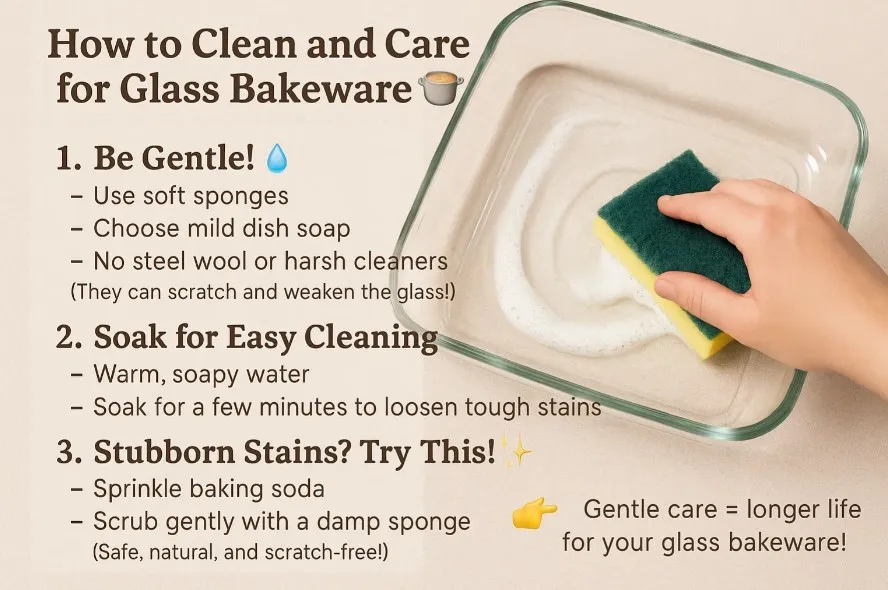
When it comes to cleaning glass bakeware, I’ve learned that gentle is the way to go. Harsh, abrasive cleaners or steel wool can scratch the surface, making the dish more prone to breaking over time. Instead, I stick to soft sponges and mild dish soap. For stubborn stains, I soak the dish in warm, soapy water for a few minutes. This loosens up baked-on food without damaging the glass.
If soaking doesn’t do the trick, I sprinkle a little baking soda on the stain and scrub gently with a damp sponge. It’s a natural and effective way to clean without risking scratches.
Tip: Avoid using sharp tools like knives to scrape off residue. They can leave permanent marks on the glass.
Allow Glass to Cool Before Washing
I’ll admit, I’ve been tempted to wash a hot dish right after taking it out of the oven. But trust me, it’s not worth the risk. Sudden temperature changes can cause the glass to crack or shatter. I always let my bakeware cool down to room temperature before washing it.
Here’s what I do:
- Place the hot dish on a trivet or a dry towel to cool.
- Wait at least 15-20 minutes before washing.
This small step has saved me from replacing broken bakeware more times than I can count.
Reminder: Never pour cold water into a hot dish. It’s a recipe for disaster!
Inspect for Chips or Cracks Regularly
I make it a habit to inspect my glass bakeware before every use. Even small chips or cracks can weaken the dish and increase the risk of it breaking in the oven. If I spot any damage, I retire the dish immediately. It’s better to be safe than sorry.
Here’s how I check:
- Hold the dish up to the light to spot any cracks.
- Run my fingers along the edges to feel for chips.
- Check the bottom for any signs of wear.
Damaged bakeware isn’t just a safety hazard—it can also affect how your food cooks. A cracked dish might not distribute heat evenly, leading to uneven results.
Pro Tip: If you’re unsure about the condition of your bakeware, replace it. It’s a small investment for peace of mind.
Store Glass Bakeware Safely to Avoid Damage
Keeping glass bakeware safe while storing is very important. It’s not just about neatness—it helps prevent chips, cracks, and accidents. Here’s how I do it.
I always stack my dishes carefully. If you have little cabinet space, stacking might seem necessary. But stacking glass directly can cause scratches or cracks. To stop this, I put a soft cloth or paper towel between each dish. This simple step really helps.
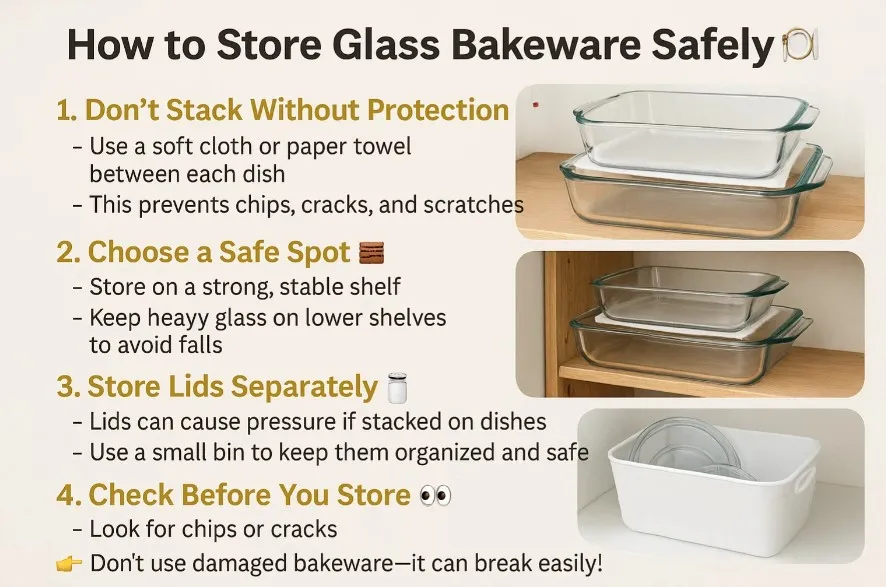
I also keep my bakeware in one safe spot. Before, I used to place it anywhere, which caused falling dishes. Now, I store it on a strong shelf where it won’t get bumped. Heavy glass dishes go on lower shelves to avoid accidents.
For lids, I store them separately. Keeping lids with bakeware can create pressure points if they don’t fit well. I use a small bin to hold all my lids. This keeps them safe and easy to find when needed.
Lastly, I check my bakeware before storing it. If I see any chips or cracks, I stop using the dish. Damaged glass breaks easily, and it’s better to stay safe.
Tip: Short on space? Try a bakeware organizer. It keeps dishes upright and stops them from touching.
These steps have saved me from broken dishes and messy cleanups. Can I use glass bakeware in the oven? Yes, but storing it properly is just as important.
Benefits of Using Glass Bakeware
Even Heat Distribution for Better Cooking
Glass bakeware spreads heat evenly during cooking. This helps avoid uneven baking. When I make lasagna or brownies, every part cooks the same. No more burnt edges or raw centers!
Here’s how different glass bakeware types help with even heat:
| Type of Bakeware | Why Even Heat Matters | Example Uses |
|---|---|---|
| Baking Dishes | Ensures food cooks perfectly | Lasagna, gratins, brownies |
| Loaf Pans | Helps bake evenly and release easily | Bread, cake baking |
This even heating makes glass my favorite for precise recipes. Can you use glass bakeware in the oven? Yes, and this is why it’s great!
Non-Reactive Surface for Safe Food Preparation
Glass bakeware doesn’t react with acidic foods like tomatoes or lemons. This keeps flavors pure and avoids harmful chemicals. Unlike metal pans, glass is safer for cooking.
Here are some reasons glass is a safe choice:
| Property | Why It’s Safe |
|---|---|
| Durability | Strong enough for high heat. |
| Heat Resistance | Handles hot temperatures without breaking. |
| Non-porous | Doesn’t soak up liquids or smells, making it clean and hygienic. |
| Thermal Conductivity | Spreads heat evenly, improving food taste. |
This non-reactive feature makes me feel good about using glass for family meals.
Easy Cleaning and Maintenance
Cleaning glass bakeware is super easy. Warm, soapy water removes most messes. For tough stains, baking soda works great.
Here’s how glass compares to other materials for cleaning:
| Material | Cleaning Ease | Maintenance Needed |
|---|---|---|
| Glass | Very easy | Low |
| Aluminum | Okay | Medium |
| Ceramic | Okay | High |
Glass saves time and effort. It’s simple to clean and lasts longer, letting me enjoy meals without extra work.
Versatility for Baking, Serving, and Storing
Glass bakeware is amazing because it does so many things. You can bake, serve, and store food all in one dish. For example, I bake casseroles, serve them right from the dish, and store leftovers in the fridge. This saves time and means fewer dishes to wash.
It’s also great with temperature changes. Pyrex can go from the oven to the table and then into the fridge without breaking. I even use it to reheat food in the microwave. Its strong design makes it perfect for these tasks. Plus, the smooth surface doesn’t hold onto smells or flavors. My lasagna never tastes like last week’s curry!
Glass bakeware also looks nice enough to use as serving dishes. Some vintage Pyrex pieces are so pretty, I use them as salad bowls or decorations. They’re both useful and stylish, which is rare.
Here’s why glass bakeware is so handy:
- Temperature Resistance: It handles heat and cold, making it great for baking, serving, and storing.
- Food Freshness: The smooth surface keeps food fresh by blocking odors and flavors.
- Multi-functional Use: It works as bakeware, mixing bowls, and even decorations.
I always grab my glass dishes when cooking. They’re dependable, easy to clean, and look great on the table. Can I use glass bakeware in the oven? Yes—and for so much more!
Glass bakeware is my favorite for cooking. It’s dependable, useful, and simple to use if handled carefully. I always make sure it’s labeled oven-safe before using it. I also take easy steps to prevent any accidents. When cared for properly, these dishes can last a long time and make cooking easier. Whether I’m baking, serving, or storing food, glass bakeware works perfectly every time. Can I use glass bakeware in the oven? Yes, and I wouldn’t choose anything else!
Frequently Asked Questions For Can I Use Glass Bakeware In The Oven
Can I use glass bakeware in a microwave?
Yes, you can! Most oven-safe glass bakeware works in microwaves too. Just make sure it doesn’t have any metal parts or decorations. I always double-check the label to be safe.
Tip: Avoid sudden temperature changes, even in the microwave. Let the dish cool before reheating.
What should I do if my glass bakeware cracks?
Stop using it immediately. Even small cracks can make the dish unsafe. I usually recycle cracked glass bakeware or dispose of it properly. It’s not worth the risk of it breaking during use.
Can I freeze food in glass bakeware?
Absolutely! Glass bakeware is great for freezing food. Just make sure it’s labeled freezer-safe. I let the dish cool completely before freezing to avoid thermal shock.
Reminder: Don’t place frozen glass bakeware directly into a hot oven. Let it thaw first.
How do I remove stubborn stains from glass bakeware?
I sprinkle baking soda on the stains and scrub gently with a damp sponge. For tougher spots, I soak the dish in warm, soapy water for a few hours. It works like magic without scratching the surface.
Is glass bakeware better than metal?
It depends on what you’re cooking. I prefer glass for casseroles and desserts because it heats evenly and looks great for serving. Metal works better for broiling or recipes needing quick heat.
Pro Tip: Use both types for different recipes to get the best results!

